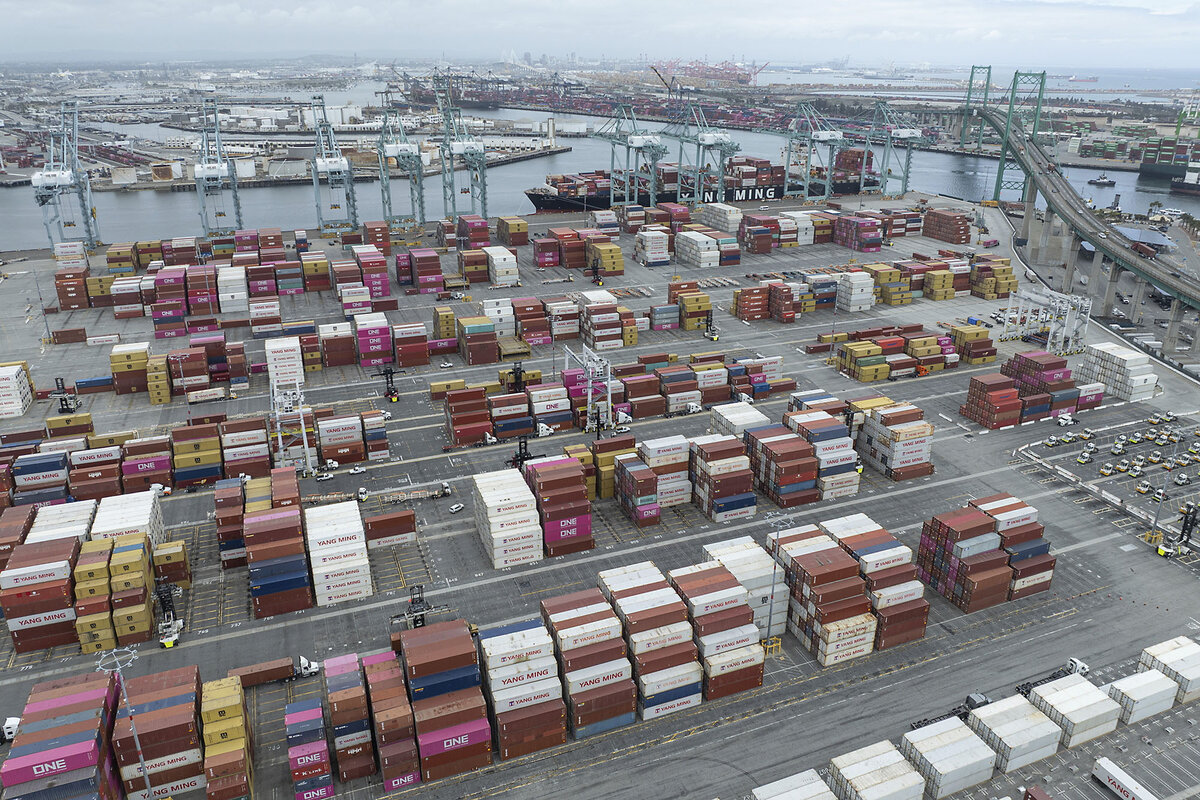Tariffs may sting LA docks. Deeper changes are coming to this blue-collar bastion.
Loading...
| Los Angeles
Few places will feel the effects of President Trump’s sweeping new tariffs on U.S. trading partners more than the nation's busiest two ports: Los Angeles and nearby Long Beach.
At stake here in the San Pedro Bay is not just dock activity but jobs. Already, amid the tumult of Trump policies, trade volume dropped sharply in May, while the port in LA hit a record high in June as importers rushed to bring in goods ahead of the president’s Aug. 1 deadline to complete trade deals.
But workers and experts say there are deeper and potentially more impactful challenges: automation and artificial intelligence.
Why We Wrote This
LA’s docks have provided stable, blue-collar work for generations. President Trump’s tariffs are being felt there, but automation and artificial intelligence will pose the biggest challenges to blending technological progress with job protection.
The transformation, already showing signs of blending technological progress with job protection, is underway – it started before Mr. Trump’s tariffs, and is expected to drive more change than any policy that comes out of the White House.
“You cannot push the genie back into the bottle,” says , who teaches about port management and shipping at Texas A&M University. “Automation is there. It’s [going to] deploy itself in ports around the world. It’s going to create surges in productivity and efficiency.”
In LA and Long Beach, where automation and AI are in use, the number of some union jobs has grown. But the relationship is complicated, riddled with concerns that advanced technologies will shrink opportunities for well-paid blue-collar work.
It doesn’t have to be either-or, says , executive director of the Port of Los Angeles. “We absolutely couldn’t live without the skilled labor. We’ll fall behind if we don’t embrace technology, but we’ve got to find a way to keep the workforce” by bringing on new technologies without sidelining humans.
Family at work and at home
On the job in the San Pedro port complex, there’s a shared sense of pride, says longshore worker Jennifer Fresquez. As a full-time union member, she is among those who get first pick of the available jobs. It took her a long time to get here: nearly 13 years of working her way up the union ladder. The work can be physically demanding and often dangerous. And she acknowledges the ups and downs that are linked to economic policy. The cargo slowdown in May, for instance, meant half the usual number of union jobs were available for a couple of weeks, she says.
But she says the career has been good for her and her family. She has the flexibility to take vacation or go to her kids’ school events. Union members like Ms. Fresquez earn generous benefits and some of the highest wages in the country, beginning at more than the national average. She feels secure with that union backing, even as jobs ebb and flow with tariffs, or the pandemic, or other world events that have played out at the ports. “There’s the good and the bad with everything,” she says “But at the end of the day, nobody can tell me, ‘Sorry you don’t have a job anymore.’”
The camaraderie is what drew her in. “We feel like we’re a family all together outside of our own family,” she says. And in many cases, they’re one and the same. Family ties are common here, where union workers often follow in the footsteps of their parents and grandparents. Ms. Fresquez’s father and stepmother worked at the ports. So does her husband and his father, Steve Palumbo, who met his wife working there.
Mr. Palumbo is retired now, but still wakes with the sun to meet other retired dockworkers for breakfast a few times a week. He takes the long view of economic policies and events, noting the growth that came after the Great Recession. Automation, he says, is the real game changer. “With automation coming along, and you start to eliminate jobs, how many jobs are going to be eliminated before it starts affecting retirement?” he asks.
There’s still time to figure that out, says Ms. Fresquez. For the next five to 10 years, she says, she’s confident the work will be there. Farther out, though, is less clear. “It’s not that I don’t think about the future, but … everything’s such a roller coaster,” she says in reference to swings at the port. “You kind of learn to just adapt.”
The docks’ future is unfolding
Adaptation is a big sticking point between the International Longshore Workers Union, which represents thousands of dock workers at the ports, including Ms. Fresquez, and the Pacific Maritime Association, which represents the shipping terminals. An estimated 100,000 people work at the LA-Long Beach complex on any given day including people like truckers, railroad workers, and municipal employees.
“The [union’s] goal is to protect jobs,” but the focus on job protection risks impeding “terminal efficiency and productivity,” says Professor Rodrigue.
The union, which did not respond to requests for comment for this story, negotiated a labor that ushered in robotics and automation to West Coast ports. In exchange for that concession, the union has won increases.
of the terminals are at least partially automated at the San Pedro complex, compared to about . And artificial intelligence runs a port optimizer at the Port of Los Angeles, which assesses the cargo coming in, identifies potential knots in the supply chain, helps plan for the needed labor, and looks for any new information that might affect operations.
With the use of those technologies over the last decade, productivity is up. The number of 20-foot containers passing through the Port of LA %, and gone up . At the same time, longshore union jobs at the two ports have increased by 27%, according to Mr. Seroka of the port of LA.
“This kind of defies many norms,” says Mr. Seroka. “But it goes back to the basic postulate that if you can bring more cargo in, it will create more jobs.”
Professor Rodrigue says new technologies can help create new jobs, such as careers managing the tech, while increasing productivity. And jobs related to shipping will increase with the port’s volume. The ripple effects will require more truckers, more warehouse workers, and more distribution centers, for instance. But the result is likely to yield fewer jobs at the ports themselves, he says.
With shipping volume increasing globally, Professor Rodrigue predicts a “reckoning” within the next 10 years, as ports worldwide reach the limitations of their infrastructure. That makes automation and AI even more important for increasing capacity by increasing efficiency, he says.
To usher in a new generation of workers, the LA and Long Beach ports are developing a training center in partnership with the ILWU, Pacific Maritime Association, and California Community Colleges. The 20-acres campus is scheduled to open in 2029.
“You’ve got to find a middle ground,” that satisfies concerns about job losses while allowing the march of progress, says Mr. Seroka. “The conversation to keep moving forward is absolutely key.”






